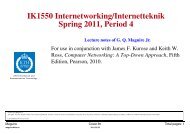An Overview of the PKCS Standards
An Overview of the PKCS Standards
An Overview of the PKCS Standards
Create successful ePaper yourself
Turn your PDF publications into a flip-book with our unique Google optimized e-Paper software.
Page 6<br />
ERROR! STYLE NOT DEFINED.<br />
The typical implementation <strong>of</strong> digital enveloping involves a secret-key algorithm for<br />
encrypting <strong>the</strong> message (i.e., a content-encryption algorithm) and a public-key algorithm<br />
for encrypting <strong>the</strong> secret key (i.e., a key-encryption algorithm):<br />
• Alice encrypts <strong>the</strong> message m with a randomly generated secret key k,<br />
obtaining an encrypted message c; <strong>the</strong>n she encrypts <strong>the</strong> secret key k with<br />
Bob's public key, obtaining an encrypted secret key ε. She sends <strong>the</strong><br />
encrypted message c and <strong>the</strong> encrypted secret key ε to Bob; <strong>the</strong> two parts<br />
toge<strong>the</strong>r form <strong>the</strong> digitally enveloped message.<br />
• Bob decrypts <strong>the</strong> encrypted secret key ε with his private key, obtaining <strong>the</strong><br />
secret key k; <strong>the</strong>n he decrypts <strong>the</strong> encrypted message c with <strong>the</strong> secret key<br />
k, obtaining <strong>the</strong> message m.<br />
Notice that Alice's work does not involve any information specific to her. Indeed, anyone<br />
can seal a message at any time for Bob, without access to any secret information. This<br />
application assumes that Alice knows Bob's public key; methods <strong>of</strong> developing trust in<br />
users' public keys are covered by <strong>the</strong> digital certificate application.<br />
Digital enveloping has three aspects that are suitable for standardization: an algorithmindependent<br />
syntax for digitally enveloped messages, specific secret-key (contentencryption)<br />
algorithms, and specific public-key (key-encryption) algorithms.<br />
Bob may need a way to store his private key securely, leading to similar aspects for<br />
standardization as those for digital signatures.<br />
3.3 Digital certification<br />
Digital certification is an application in which a certification authority "signs" a special<br />
message m containing <strong>the</strong> name <strong>of</strong> some user, say "Alice," and her public key in such a<br />
way that anyone can "verify" that <strong>the</strong> message was signed by no one o<strong>the</strong>r than <strong>the</strong><br />
certification authority and <strong>the</strong>reby develop trust in Alice's public key.<br />
The typical implementation <strong>of</strong> digital certification involves a signature algorithm for<br />
signing <strong>the</strong> special message. (A signature algorithm is chosen here, ra<strong>the</strong>r than a messagedigest<br />
algorithm followed by a message-digest encryption algorithm, as in <strong>the</strong> digital<br />
signature application, because X.509 certificates only use a signature algorithm.)<br />
• Alice sends a "certification request" containing her name and her public key<br />
to a certification authority.<br />
• The certification authority forms a special message m from Alice's request<br />
and signs <strong>the</strong> special message m under its private key, obtaining a signature<br />
σ. The certification authority returns <strong>the</strong> message m and <strong>the</strong> signature σ to<br />
Alice; <strong>the</strong> two parts toge<strong>the</strong>r form a certificate.

















